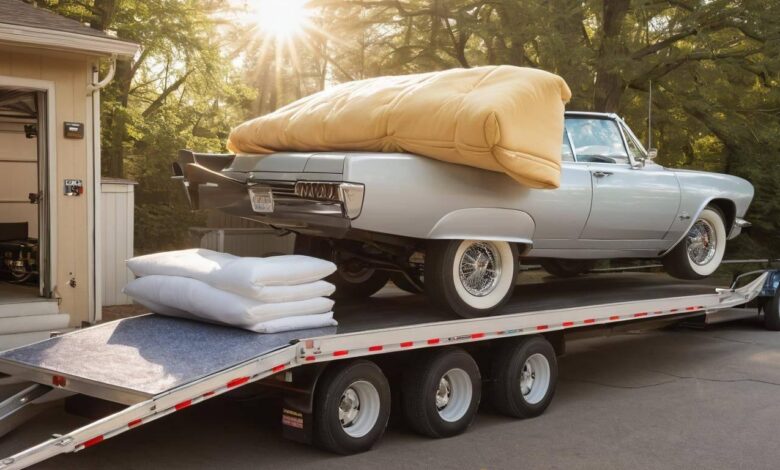How to Ship a Classic or Exotic Car: Best Practices for Safe Transport

When it comes to shipping your beloved classic or exotic car, it’s akin to trusting a fragile piece of history in someone else’s hands. The thought alone can cause endless worry over potential damage or theft, much like parting with a cherished family heirloom.
However, armed with the right information, you can alleviate those fears and ensure a smooth, secure journey for your vehicle. Through meticulous research, consultations with experts in automotive logistics, and verified reviews from fellow car collectors, we’ve gathered comprehensive insights to help you navigate this daunting process. Our guide dives into selecting trustworthy shipping companies—because ensuring your vehicle’s safe arrival starts with placing it in capable hands.
The best practices for shipping a classic or exotic car according to Exotic Car Transport include selecting a reputable and insured auto transport service, opting for enclosed transportation to protect your vehicle from environmental damage, and ensuring you have adequate insurance coverage during transit. Additionally, conducting a thorough pre-shipment inspection and documenting your car’s condition with photos can help safeguard against potential damages.
Researching Vehicle Shipping Companies
When it comes to transporting a classic or exotic car, doing thorough research on vehicle shipping companies can mean the difference between smooth sailing and a bumpy ride. Start by narrowing down your options to specialists in the field, as these companies understand the unique requirements that come with handling high-value vehicles. The level of care they exercise—from how they handle your car during loading and unloading to their methods of securing it for transport—can significantly impact your car’s condition upon arrival.
Narrow Down to Specialists
Focus specifically on companies that have a track record of working with classic or exotic cars. These specialists are well-versed in the intricacies of shipping valuable automobiles. For instance, firms like EasyHaul and Cruise Control Auto Transport have built solid reputations catering to this niche market, embodying qualities such as reliability and expertise.
It’s interesting to note that according to industry reports, about 70% of transported classic cars reach their destination without any issues when shipped by such specialists. This statistic highlights why investing time into researching dedicated companies is so important.
While identifying specialized companies, it’s equally essential to gauge their reputation through customer experiences.
Check Reviews and Ratings
Utilize credible platforms such as the Better Business Bureau (BBB), Transport Reviews, and Google Reviews for checking ratings and reading customer feedback. Ensuring transparency through these resources can save you potential headaches down the line. A good rule of thumb is to look for companies with at least a 4 out of 5-star rating; this indicates a generally positive experience among users.
Additionally, take the time to read both positive and negative reviews for a balanced understanding of any company’s strengths and weaknesses. Key factors to consider include:
- Customer service quality: Do they communicate effectively and provide updates during transport?
- Timeliness in delivery: Are they known for delivering on schedule?
- Handling of vehicles: How meticulously do they manage the vehicles in transit?
Once you’ve got an idea of which companies might fit your needs, it doesn’t hurt to verify their legitimacy.
Verify Credentials
Before finalizing your choice, ensure that the company you’re considering is properly insured, bonded, and possesses all necessary licenses to operate legally. This validation adds an essential layer of security for your investment.
To do this, visit the Federal Motor Carrier Safety Administration’s (FMCSA) website where you can easily verify licenses while also checking for any filed complaints against the company you’re interested in using.
With proper research and the right credentials confirmed, you’re positioned well for ensuring that your vehicle will receive safe and secure transport.
Choosing Enclosed vs. Open Transportation
Deciding between enclosed and open transport is a critical step in shipping your classic or exotic car because it directly impacts the safety and condition of the vehicle during its journey.
Enclosed transportation offers a higher level of protection, safeguarding your car from external elements like rain, hail, and road debris. This method is often regarded as the gold standard for transporting high-value vehicles. Not only does it shield against unpredictable weather patterns that may arise on long hauls, but it also prevents exposure to potential scratches or dents caused by flying rocks or other road hazards. Investing in this extra layer of protection can maintain your car’s pristine appearance and value.
Enclosed Transportation
The term “enclosed transportation” refers to the use of a sealed trailer designed specifically for safe vehicle transport. Given that your classic car represents not just a mode of transport, but often a treasured investment, it’s understandable why many choose this method. While enclosed transportation typically costs about 50-60% more than open transport, the unparalleled protection it offers makes it worthwhile for many owners.
Now consider this: what if you’ve decided to ship an iconic sports car? You wouldn’t want rainwater pooling on its flawless surface or paint chips from roadside debris ruining its sleek lines. With enclosed transport, you gain peace of mind knowing that your vehicle is not only shielded from the elements but also kept secure from theft or vandalism.
Open Transportation
On the other hand, open transport is characterized by loading vehicles onto an open trailer where they remain exposed to the environment throughout their transit. While it is generally a more affordable option, costing approximately 30-50% less than its enclosed counterpart, it does come with drawbacks. The principal risk is exposure to weather conditions and debris, which can cause damage unless the vehicle being transported is somewhat rugged or less valuable.
Think about how much you’d be willing to risk when shipping your everyday vehicle—a used sedan perhaps—as opposed to something rare and vintage. Open transport might be a sensible choice here, especially for short-distance moves where severe weather conditions are less likely to affect transit. However, it isn’t recommended for classic or luxury cars that could suffer significant devaluation from minor damages due to exposure.
Cost Comparison
| Type of Transport | Average Cost (per mile) | Protection Level |
| Enclosed | $1.00 – $1.50 | High |
| Open | $0.50 – $0.75 | Moderate to Low |
The choice between enclosed and open transport should balance your budgetary constraints with your desire to protect and preserve your vehicle. Understanding these factors will better prepare you for what comes next—ensuring your vehicle is ready for an efficient and safe voyage.
Preparing Your Vehicle for Transport
To ensure your car arrives safely at its destination, proper preparation is essential. Start with a thorough cleaning. This isn’t just about aesthetics—cleaning your car makes it easier to identify any pre-existing dents, scratches, or damage that may otherwise go unnoticed. When you wash the exterior, focus on the nooks and crannies where dirt and grime settle. Pay special attention to the wheels and undercarriage, as these areas often accumulate debris that can obscure damage.
Once it’s spotless, it’s time to document its condition.
Documenting Condition
Take clear and dated photos and videos of your car, capturing multiple angles and close-ups of any imperfections. This documentation serves as an important record for both you and the shipping company. It becomes invaluable if any disputes arise regarding the condition of the vehicle upon arrival. Be meticulous in your approach—include interior shots and details like the odometer reading and overall cleanliness, which provide additional context for the vehicle’s state prior to transport.
After capturing this visual record, create a detailed list of any existing damage, noting their locations and descriptions. This list will not only help you maintain a good reference but can also assure shippers that you are proactive about your car’s care.
With documentation completed, shift your focus to personal items inside the vehicle.
Removing Valuables
It is crucial to remove all personal items and valuables from your car, including GPS systems, custom accessories, and important documents. Not only do these items risk damage during transit, but they may not be covered by insurance should something happen while shipping. Create a checklist of items you need to remove before handing over your keys—this could include anything from sunglasses left in the cup holder to personal files stowed in the glove compartment.
Leaving items in the car can lead to potential loss or liability issues, so it’s better to err on the side of caution.
Next, make sure everything is mechanically sound before shipping.
Fluid Levels and Battery
Check all fluid levels—engine oil, coolant, brake fluid, and windshield washer fluid—to ensure they are at recommended levels. A well-maintained car has higher chances of surviving transport without incident. Also, ensure that the battery is fully charged; after all, you want to drive away smoothly once it reaches its destination.
Additionally, secure or remove loose parts like spoilers or roof racks that could become dislodged during transit. These preparations protect not just your vehicle’s integrity but also its overall appearance.
With your car meticulously prepared and ready for transport, coordinating with your chosen carrier becomes essential for smooth logistics as you approach the next phase of planning your shipment logistics.
Coordinating Your Shipment Schedule
Properly planning your shipment schedule is crucial for minimizing delays and logistics roadblocks that can disrupt the entire process. A well-timed shipping plan ensures not only that your classic or exotic car arrives safely but also that you experience peace of mind throughout the journey. Think of it as setting up the dominoes; if one is out of place, the whole array may fall into disarray.
Timing the Shipment
When it comes to scheduling, booking your shipping date well in advance is paramount—aim for at least a month ahead, especially during peak seasons like summer. The demand for car shipping services during these times can skyrocket, making it challenging to secure reliable transportation on short notice. Start by researching reputable shipping companies and their availability; this proactive step can save you stress down the line.
Additionally, communicate with the shipping company regarding pickup and delivery times. They have insights into typical timelines that apply to various routes, helping you set realistic expectations based on your specific needs.
Flexible Scheduling
Life is full of surprises, and so is vehicle transport. Weather conditions, road closures, or other unforeseen events can lead to changes in schedule. As such, cultivating a flexible mindset when it comes to shipping will help avoid frustration. Instead of rigidly adhering to predetermined dates, consider establishing a window for both pickup and delivery.
Imagine planning a road trip with friends: you agree on a destination but leave room for spontaneous stops along the way. This same principle applies to coordinating your car shipment. By allowing some latitude in timing, you’re better equipped to handle any hiccups that may arise while still ensuring your vehicle reaches its destination safely.
As we shift focus now to protecting your valuable asset during transport, it’s essential to understand the importance of adequate coverage options available in the market.
Ensuring Proper Insurance Coverage
When shipping a classic or exotic car, having peace of mind stems from knowing that your vehicle is adequately insured. This insurance isn’t merely a formality; it’s an essential safeguard against potential risks associated with transport. Think about it: these cars are not only valuable in terms of money but often carry emotional significance as well.
Verify Coverage
Start by confirming that the shipping company you choose has an insurance policy that specifically covers high-value vehicles like yours. Not every carrier possesses the right coverage, and many policies might fall short when applied to classic or exotic cars. It’s important to request documentation proving this coverage before committing—trust me, this small step can save you significant troubles later on. As a general guideline, domestic shipments should ideally boast at least $100,000 in coverage. This figure ensures you’ve got adequate protection against damage, theft, or loss during transit.
Additional Insurance
However, if the company’s insurance doesn’t meet your expectations, don’t hesitate to seek additional coverage. This decision can be likened to installing an extra lock on your front door; while it may seem unnecessary at first, it substantially fortifies your defenses against unforeseen circumstances. Many specialized insurers exist who cater specifically to high-end vehicles, providing tailored options for transport situations. It’s worth exploring these alternatives to find coverage that suits your needs.
Insuring Inoperable Cars
If your vehicle is inoperable—perhaps due to being a restoration project or simply unable to start—make sure to clarify whether the shipping company’s insurance covers this unique category of risk. Transporting non-running vehicles often requires specialized equipment and techniques (like winches or flatbed trailers), which could introduce additional risks during the move. Confirming your insurance comprehensively includes supplementation for these factors will provide you with even greater security on moving day.
Understanding these aspects of insurance provides a crucial foundation for ensuring a smooth transportation experience for your prized vehicle. Next, we will explore essential strategies that enhance both safety and overall protection throughout the moving process.
Best Practices for Safety and Protection
One of the cornerstones of a successful vehicle shipment is constant communication. It’s essential to maintain regular contact with your shipping company throughout the entire process. When you check in, you alleviate your own anxiety and ensure that both you and the transport team are on the same page. By requesting updates on your vehicle’s location and estimated delivery time, you’re safeguarding your investment. Knowing where your car is at all times allows you to prepare better for its arrival, giving you peace of mind.
As you communicate with your carrier, it’s equally important to be organized about securing your documents. Before the journey even begins, gather all necessary paperwork related to the transport. This includes the bill of lading—a crucial document that serves as a legal contract between you and the shipping company, detailing the specifics of the shipment. Having this documentation accessible makes it easier to address any concerns that may arise during transit. Storing copies in a safe place, separate from the originals, acts as a protective measure against potential issues during or after transport.
Upon delivery of your vehicle, always conduct a final inspection. This step can’t be overstated in its importance; once your car is back in your possession, it’s time to meticulously examine every aspect for any signs of damage accrued during transportation. If you took pre-shipment pictures, now’s the moment to refer back to them and compare your car’s current state to its condition before shipment. If discrepancies emerge—whether it’s scratches, dents, or any operational issues—reporting them immediately to the shipping company is vital. Promptly addressing these concerns facilitates smoother discussions on liability or claims if necessary.
“I shipped my vintage Mustang using these guidelines and it arrived in perfect condition,” shared John, a classic car owner from Miami.
By diligently adhering to these practices—effective communication, diligent documentation, and thorough inspections—you position yourself well to ship your classic or exotic car securely and confidently. Every action contributes not only to protecting your prized vehicle but also to enhancing your overall shipping experience.
In summary, following established best practices ensures a safe transport for your classic or exotic car while minimizing risks during the process. Adhering to these guidelines will help maintain both the vehicle’s condition and its value over time.
Keep an eye for more news & updates on Tech Pro Magazine!





